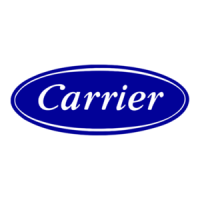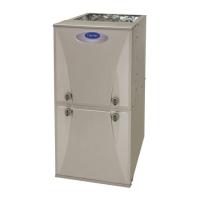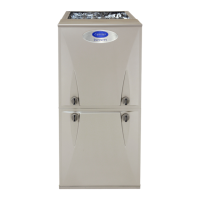PG92MSA: Installation, Start-up, Operating and Service and Maintenance Instructions
Manufacturer reserves the right to change, at any time, specifications and designs without notice and without obligations.
7
Duct Systems
• US and CANADA: Current edition of Air Conditioning Contractors
Association (ACCA) Manual D, Sheet Metal and Air Conditioning
Contractors National Association (SMACNA), or American Society
of Heating, Refrigeration, and Air Conditioning Engineers
(ASHRAE) Fundamentals Handbook Chapter 35
Acoustical Lining and Fibrous Glass Duct
• US and CANADA: Current edition of SMACNA, NFPA 90B as tested
by UL Standard 181 for Class I Rigid Air Ducts
Gas Piping and Gas Pipe Pressure Testing
• US: Current edition of NFPA 54/ANSI Z223.1 NFGC; Chapters 5, 6,
7, and 8 and national plumbing codes.
CANADA: Current edition of CAN/CSA-B149.1, Parts 4, 5, 6, and 9.
In the state of Massachusetts:
• This product must be installed by a licensed plumber or gas fitter.
• When flexible connectors are used, the maximum length shall not
exceed 36 in. (914 mm).
• When lever type gas shutoffs are used they shall be T-handle type.
• The use of copper tubing for gas piping is not approved by the state of
Massachusetts.
Electrical Connections
• US: Current edition of National Electrical Code (NEC) NFPA 70
• CANADA: Canadian Electrical Code CSA C22.1
Condensate Drain Connection
• US: Current edition of National Standard Plumbing Code, Section 8.7.
• Canada: Current edition of National Plumbing Code of Canada in
Canada.
ELECTROSTATIC DISCHARGE (ESD)
PRECAUTIONS PROCEDURE
1. Disconnect all power to the furnace. Multiple disconnects may be
required. DO NOT TOUCH THE CONTROL OR ANY WIRE
CONNECTED TO THE CONTROL PRIOR TO DISCHARGING
YOUR BODY’S ELECTROSTATIC CHARGE TO GROUND.
2. Firmly touch the clean, unpainted, metal surface of the furnace
chassis which is close to the control. Tools held in a person’s hand
during grounding will be satisfactorily discharged.
3. After touching the chassis, you may proceed to service the control
or connecting wires as long as you do nothing to recharge your
body with static electricity (for example; DO NOT move or shuffle
your feet, do not touch ungrounded objects, etc.).
4. If you touch ungrounded objects (and recharge your body with
static electricity), firmly touch a clean, unpainted metal surface of
the furnace again before touching control or wires.
5. Use this procedure for installed and uninstalled (ungrounded)
furnaces.
6. Before removing a new control from its container, discharge your
body’s electrostatic charge to ground to protect the control from
damage. If the control is to be installed in a furnace, follow items 1
through 4 before bringing the control or yourself in contact with the
furnace. Put all used and new controls into containers before
touching ungrounded objects.
7. An ESD service kit (available from commercial sources) may also
be used to prevent ESD damage.
ACCESSORIES
See Product Data for a list of accessories for this product.
LOCATION
General
These furnaces are shipped with materials to assist in proper furnace
installation. These materials are shipped in the main blower
compartment.
See Table 3 for loose parts bag contents.
This furnace must:
• be installed so the electrical components are protected from water.
• not be installed directly on any combustible material other than wood
flooring (refer to SAFETY CONSIDERATIONS).
• be located close to the chimney or vent and attached to an air
distribution system. Refer to Air Ducts section.
• be provided ample space for servicing and cleaning. Always comply
with minimum fire protection clearances shown in Table 2 or on the
furnace clearance to combustible construction label.
The following types of furnace installations may require OUTDOOR
AIR for combustion due to chemical exposures:
• Commercial buildings
• Buildings with indoor pools
• Laundry rooms
• Hobby or craft rooms
• Chemical storage areas
If air is exposed to the following substances, it should not be used for
combustion air, and outdoor air may be required for combustion:
• Permanent wave solutions
• Chlorinated waxes and cleaners
• Chlorine based swimming pool chemicals
• Water softening chemicals
• De-icing salts or chemicals
• Carbon tetrachloride
• Halogen type refrigerants
• Cleaning solvents (such as perchloroethylene)
• Printing inks, paint removers, varnishes, etc.
• Hydrochloric acid
• Cements and glues
• Antistatic fabric softeners for clothes dryers
• Masonry acid washing materials
All fuel-burning equipment must be supplied with air for fuel
combustion. Sufficient air must be provided to avoid negative pressure
in the equipment room or space. A positive seal must be made between
the furnace cabinet and the return-air duct to prevent pulling air from the
burner area.
CAUTION
!
FURNACE RELIABILITY HAZARD
Failure to follow this caution may result in unit component damage.
Electrostatic discharge can affect electronic components. Take
precautions during furnace installation and servicing to protect the
furnace electronic control. Precautions will prevent electrostatic
discharges from personnel and hand tools which are held during the
procedure. These precautions will help to avoid exposing the control to
electrostatic discharge by putting the furnace, the control, and the
person at the same electrostatic potential.

